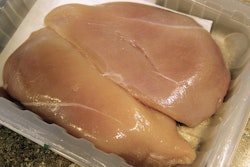
The U.S. poultry industry is seeing scary levels of regulatory scrutiny and uncertainty.
As 2022 ends, and the Biden Administration faces a challenge to its legislative alliance in Congress in coming midterm elections, a relative flurry of activity is coming out of the U.S. government concerning the poultry industry.
All these actions, alarmingly, could seriously impact the industry. That’s a highly unusual development for an industry usually out of the spotlight.
Salmonella as an adulterant
In August 2022, the U.S. Department of Agriculture’s (USDA) Food Safety and Inspection Service (FSIS) announced it will classify Salmonella as an adulterant in certain types of breaded and stuffed raw chicken products.
Adulterated products are banned from sale and a company could face legal consequences for selling it. The FSIS announcement at the time said it will define a product as adulterated when it exceeds a limit of one colony forming unit of Salmonella per gram.
This announcement is not yet backed up with any legally binding actions by the USDA. In August, the agency said it will publish a notice in the Federal Register “in the fall.” That begins the convoluted federal rulemaking process.
When exactly Salmonella would be, or even will be, declared an adulterant remains uncertain.
The broader implications of this decision are chilling for the poultry industry. This dovetails with the fog created by the FSIS' announced intent to overhaul how it regulates the pathogen in 2021.
Despite years of advances in pathogen control, there will never be a sterile chicken product. People need to cook it right for optimal food safety, but many don’t. The regulators are choosing to try to have the supply chain control pathogen spread.
Line speed waivers
In July 2022, FSIS sent 55 poultry plants with a line speed waiver to process 175 birds per minute a notice about a new, nominally optional third-party worker safety study that would take place at their plants. If they chose to opt out, however, the line speed waiver would be yanked.
The first deadline to opt in or out of the study apparently passed on September 1, 2022. However, other deadlines pass later in the fall. Also on September 1, members of Congress sent a letter to the USDA urging a pause in the process.
Its unclear where exactly this situation stands now. If plants do lose their line speed waivers, it would mean cutting the speed of the operation by 25%, to 140 birds per minute, over the course of 60 days.
Moreover, it would be a serious blow to the plants, plant staff, integrators – and even the regulators themselves – who worked so diligently for so long through the various iterations of the New Poultry Inspection System (NPIS) process to create the current system with the increased line speed.
What exactly the third-party worker safety study would entail is unclear, too. But there’s concern about disclosing information, or making certain information public record, that could be weaponized against the poultry industry by spin masters at various activist groups.
Activists want to make the plants look unsafe for workers but would delight in making chicken look unsafe to eat, too. Check your local or national news, or even Facebook newsfeed. Food recalls and food safety stories are what people hear more than anything else about agriculture.
Competitive grower pay
Perhaps the real gold ring for the Biden Administration is ending, or seriously modifying, the tournament system used by most of the U.S. poultry industry to pay growers.
In June 2022, the USDA’s Agricultural Marketing Service – which now oversees the enforcement of the Packers & Stockyards Act – published a proposed rule on transparency in poultry grower contracting and tournaments.
The new rules would compel integrators to release a flurry of financial and biological data for the birds each time a contract is signed. Moreover, it would require integrators to release similar information to growers at the start and end of every flock. That report would include performance data for other farmers in the growers grouping.
These changes, according to the USDA at least, would decrease the likelihood of growers being deceived because they are ignorant of the data and give the growers greater leverage in contract negotiations because the grower would have a better idea of what they will earn.
Apparently, this is just one of a few proposals circulating around the Beltway concerning the Packers & Stockyards Act. What the rest will do is unclear but it looks like the grower pay system in the U.S. may be in the crosshairs.
















